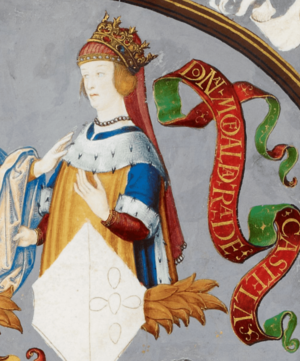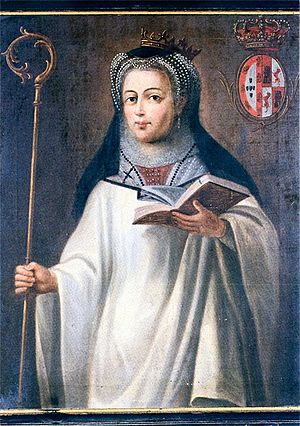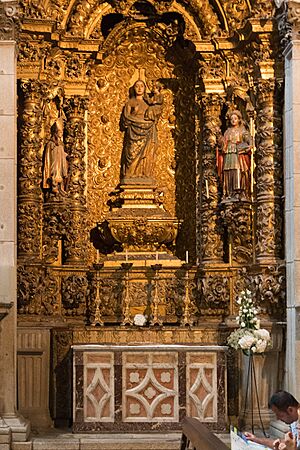Mafalda of Portugal facts for kids
Quick facts for kids Mafalda of Portugal |
|
|---|---|
| Lady of Arouca | |

Mafalda in Genealogy of the Kings of Portugal (António de Holanda, 1530–1534)
|
|
| Queen consort of Castile | |
| Tenure | 1215–1216 |
| Born | c. 1195 Kingdom of Portugal |
| Died | 1 May 1256 (aged 61) Rio Tinto, Gondomar, Kingdom of Portugal |
| Burial | Arouca Abbey, Arouca, Porto, Portugal |
| Spouse | |
| House | Portuguese House of Burgundy |
| Father | Sancho I |
| Mother | Dulce of Aragon |
| Religion | Catholic Church |
| Blessed Mafada of Portugal, O.Cist |
|
|---|---|

|
|
| Virgin | |
| Venerated in | Catholic Church (Cistercian Order) |
| Beatified | 27 June 1792, Rome, Papal States by Pope Pius VI |
| Feast | 20 June |
Infanta Mafalda of Portugal (born around 1195 – died May 1, 1256) was a Portuguese princess. She was also known as Blessed Mafalda. For a short time, she was the Queen consort of Castile.
Mafalda was the daughter of King Sancho I of Portugal and Dulce of Aragon. She was briefly married to Henry I of Castile. After her marriage ended, Mafalda returned to Portugal. She decided to become a Cistercian nun. She was known for living a very holy life. The Catholic Church declared her "Blessed" many centuries after her death.
Life Story
Early Years
Mafalda of Portugal was born around the year 1195. Her parents were King Sancho I of Portugal and Queen Dulce of Aragon.
When her father, King Sancho I, passed away, he left Mafalda some important things in his will. She was supposed to receive Seia Castle and its surrounding area. She would also get all the money that came from that land. Her father's will also said she could use the title of "queen."
This caused a disagreement with her brother, Afonso II. He wanted to have all the power in the country. He did not want his sisters to have these titles and rights. Afonso worried that if his sisters, Teresa and Sancha, also had such rights, it could divide the country. Many nobles in Portugal supported Mafalda and her sisters. However, Afonso II's side won the conflict.
Later, when Afonso II died, his son Sancho II gave some lands and castles to his aunts. But he made them give up the title of "princess-queen." Peace finally came in 1223.
Her Marriage
In 1215, Mafalda was part of a political marriage. She married her young cousin, Henry I of Castile. Henry was only about ten years old at the time. Because of his young age, the marriage was never fully completed. It was ended the next year because they were too closely related (this is called consanguinity). After this, Mafalda went back to Portugal.

Life as a Nun
In 1220, Mafalda decided not to marry again. Instead, she became a nun at the Arouca Abbey. She was allowed to keep control of her family inheritance. She became the leader, or abbess, of the nuns there. At that time, they were Benedictine nuns. In 1226, the pope allowed her request to change the abbey to the Cistercian Order.
Mafalda was very devoted to Our Lady of Silva. She gave a lot of money and gifts to the shrine. She also had a special place built for travelers to stay, called a hospice. She helped build many bridges, churches, monasteries, and hospitals. She helped make her abbey a very important religious center in the area for many years.
Mafalda became ill when she was returning from a trip to the shrine of Our Lady of Silva. She passed away at a Cistercian monastery in Rio Tinto on May 1, 1256.
In 1616, people wanted to move her body back to Arouca. This was part of the process to make her a saint. When they found her body, it had not decayed. This led to many people feeling great devotion to the Portuguese princess. She was declared "Blessed" in 1792 by Pope Pius VI. Her special day is celebrated on June 20, along with her two sisters.
See also
 In Spanish: Mafalda de Portugal para niños
In Spanish: Mafalda de Portugal para niños

